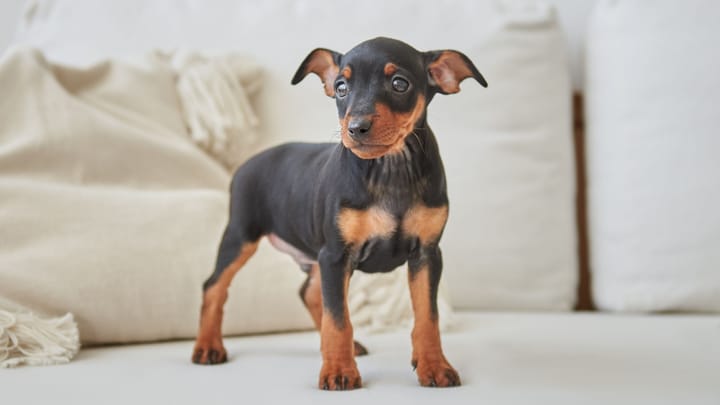Pinscher
Other names : Miniature Pinscher, Zwergpinscher, Medium Pinscher, German Pinscher, Deutscher Pinscher, Min Pin, King of Toys


The Pinscher exists in two varieties: the medium one, commonly called German Pinscher, and the miniature one, also known as “toy”. The main elements that differentiate them are their size, but also the watchdog aspect of the German variety. Otherwise, they are as energetic and lively as one another and both resemble a miniature Doberman, even if they have little in common with the latter.
|
Life expectancy |
The Pinscher has a life expectancy of between 12 and 15 years |
|
Temperament |
|
|
Size |
Medium
|
|
Adult size |
Female
Between 18 and 20 in
Male
Between 18 and 20 in
|
|
Adult weight |
Female
Between 31 and 44 lb
Male
Between 31 and 44 lb
|
|
Coat colour
The coat can be a solid colour (deer red, from red-brown through to dark red-brown) or black and tan (jet black with red or brown patches). |
Black Brown Red Blue |
|
Type of coat
The hair is short. The coat is luscious, shiny, laying flat over the dog’s body. No bald areas (hairless) are authorised by official standards. |
Very short |
|
Eye colour
The eyes are dark. |
Brown
|
|
Purchase price |
The Pinscher costs between £540 and £730 |
The miniature Pinscher is a consequence of crossing several breeds, including the German Pinscher (medium-sized variety), the Italian Greyhound, and the Dachshund.
More details about the Pinscher
Pinscher: Origins and history
As archeological elements dating back to the neolithic era can attest to, these dogs have prehistoric roots. The origins of the miniature variety, however, are recent: it was created in Germany, in the second half of the past century. The standard was established in Germany in 1895, and the first Breed Club was founded in the same year. Both varieties are descendants of the Doberman. Both varieties were officially recognised by the FCI in 1955, and possess their own, distinct official standards.
Physical characteristics of the Pinscher
They are proportionally-built dogs, with a clean-cut profile and harmonious traits, generally harmonious-looking. The medium-sized variety resembles a miniature Doberman. The miniature breed should never present signs of dwarfism (such as saggy eyes, enlarged back of the head, etc.). The anatomy of the torso must be as square-shaped as possible. The head is robust and elongated, with a straight muzzle, and a subtle but perceptible stop. The eyes are medium-sized and oval. The ears, when they are whole, are attached quite high, and can hang into a V-shape folding forwards, or be naturally erect. The limbs are straight and perfectly upright. The tail hangs high.
Pinscher: Varieties
- Medium Pinscher ( German Pinscher, Deutscher Pinscher)
- Miniature Pinscher (Zwergpinscher, Toy Pinscher)
Pinscher: Characteristics
Pinscher: Behaviour
Training a Pinscher
Both varieties are relatively easy to train. Attached to their owners and eager to please, these miniature Dobermans are very cooperative if the training methods are respectful, fair, and coherent.
Brutality must never be part of the tactics used by the owners as this little dog cannot stand violence or groundless reprimands. With a moderately firm hand, you will have to prioritise the reinforcement of good behaviours.
This dog is known to be stubborn, but if the proverbial “iron fist in a velvet glove” is applied, nothing should stand in the way of a good interaction between master and dog.
Be wary regarding the Zwerg (the miniature version), as one often tends to be indulgent with him, citing his small size as a reason- letting them tug and jump etc. This is in no way a good solution! Diligence and consistency must be at the core of training a dog, no matter its size.
Pinscher: Lifestyle
Breed compatibility Pinscher
Pinscher: Purchase price
The price of a Pinscher varies depending on its origins, age, and gender. You have to count an average of £730 for dogs subscribed to the Kennel Club.
The monthly budget required to cater to this dog’s physiological needs wavers in between £20 and £30, depending on the dog’s size, with quality nutrition and necessary yearly basic care (vaccines, deworming, etc.) taking priority.
Pinscher: Shedding
Light
The absence of an undercoat renders moulting seasons irrelevant.
Pinscher: Grooming
This dog is very easy to maintain because the absence of an undercoat does not require daily brushes, not even during the typical moulting seasons. This short-haired dog will nevertheless need weekly brushes to maintain his quality, pristine coat.
Pinscher: Health
The average life expectancy is 14 years.
It is a rather robust dog who nonetheless, on account of his size, remains somewhat fragile in certain aspects.
Even if he is quite resistant to heat, fresh water must always be made available to the dog, especially in times of significant heat.
The absence of an undercoat renders this little dog quite vulnerable to bad weather and humidity. It’s not rare to see certain representatives of the breed sporting coats during wintertime.
This athletically-built dog’s dynamic nature and constant activity, coupled with a moderate appetite, make it unlikely to gain excessive weight.
- Cancer (canine histiocytoma)
- Skin conditions (color dilute alopecia)
- Diabetes mellitus, especially in elderly non-sterilised females
- Immune mediated hemolytic anemia
- Cystine stones (a consequence of renal anomalies)
- Acral mutilation syndrome
- Progressive retinal atrophy
- Cataracts
- Corneal dystrophy
- Dislocation of the lens
- Dislocation of the patella
- Eclampsia or puerperal tetany (a consequence of difficulty in labour)




